

If we all locked ourselves in a room and HAD to agree on one statement before we could escape, what do you think that statement would be?
I’m guessing our prisoner situation would spark some heated debates. At some point, the pitchforks and flame torches might come out. But, after a few hours of wrestling and a black eye or two, I’d bet we could find one statement nobody dared to contend:
Hard work pays off.
In most areas of life, this is a perfectly reasonable statement. You’d be crazy to suggest otherwise.
Except, as it turns out, for when it comes to investing.
In fact, in the upside-down world of investing, all evidence points towards the opposite. In investing, study after study shows that the harder you work, the worse you do.
Have I lost you yet? Perfect.
Because today, I’m highlighting an investing strategy so simple that it just might work. In this mega post, I’m going to show how my favorite investing strategy – the 3 Fund Portfolio – can knock the socks off even the most hot shot money managers.
And then, I’m going to show you exactly how to do it.
What is a 3 Fund Portfolio?
Brace yourself for the boring definition of the year. A three fund portfolio is an investment portfolio which… consists of just three funds. *GASP*
More specifically, those three funds invest in the following asset classes.
- US Stocks
- US Bonds
- International Stocks
That’s it.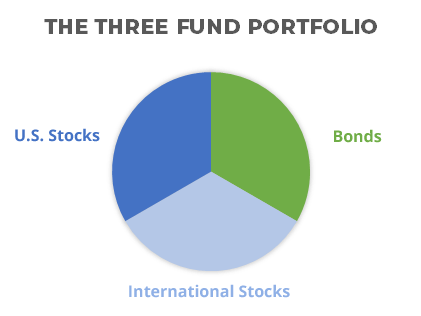
How does the 3 Fund Portfolio work?
Well, a three fund portfolio doesn’t use any old fund. A proper three fund portfolio invests in the lowest cost index funds around, so you get broad diversification at the cheapest cost.
The result? Returns that are guaranteed to match the overall market, so you don’t have to worry about a boneheaded decision costing you thousands. (A boneheaded decision from yourself, or from your investment manager.)
Instead, you’ll cruise along earning average returns, which counter-intuitively places you above oh… about 99% of stock pickers.
And then, the Three Fund Portfolio takes things to the next level. By adding multiple asset classes, you’re now diversified not just in the market itself, but across three (mostly) uncorrelated markets. This provides your cool self with protection against wild swings in any one individual market.
As the theory goes, if the United States stock market is shaken up by Americans defaulting on their oversized homes, Facebook creeping a little too much on their users, or even robots trading too quickly for the market’s comfort, then maybe our market’s temporary decline can still be offset by Canada striking liquid gold with a new oil reserve, China showing promising growth, or Russia becoming a little less corrupt.
And of course, there’s the always the bond market, quietly working away to provide steady fixed income, and often moving in the opposite direction as stocks.
Over time, research shows this type of three-pronged attack can provide better risk adjusted returns than if you tried hitting a home run with any one stock choice or even any one index fund.
As the saying goes, there’s no such thing as a free lunch… Except for diversification.
But is that all this strategy has going for it?
Oh no… we’re just getting started with the awesomeness.
Advantages of a Three Fund Portfolio
1) Diversification – we just covered the basics, but it’s worth highlighting that the index funds in a typical Three Fund Portfolio track over 11,000 different stocks. You’ll have exposure to the largest companies in the United States to the smallest companies in China.
2) Low cost – The large index funds typically used to create a 3 Fund Portfolio are THE least expensive funds to own. Remember, small percentage changes in fees can cause thousands or even hundreds of thousands of dollar swings to our future wealth.
In a nutshell, low costs matter. Big time.
3) Easy Rebalancing – Rebalancing is the process of periodically adjusting portfolio allocations to make sure you’re still on target.
Imagine a traditional buy and hold investor, who may have 30+ companies to monitor. Even a traditional index fund investor might have a dozen different index funds, all performing basically the same purpose as what’s captured in a Three Fund Portfolio.
Compared to this, rebalancing a Three Fund Portfolio is insanely easy. (And even easier when using a free tool like Personal Capital for automatic monitoring.)
4) Simplicity – Put bluntly, the Three Fund Portfolio is easy to understand, easy to implement, and easy to monitor. Which is why it’s my overall favorite strategy for everyone ranging from total investing beginner to total money nerd.
Okay, so this all sounds pretty sweet. But what about the performance? Is this whole thing too simple?
Let’s take a look…
3 Fund Portfolio Performance
Narv Narvekor is by all measures, a brilliant financial mind. He received his MBA from the internationally renown Wharton School of Business before climbing to Managing Director of Equity Derivatives (fancy!) at JP Morgan. From there, he headed to Warren Buffett’s alma mater, Columbia University, where he led investing strategies for their entire endowment portfolio.
Today, he’s the CEO of Harvard’s massive $36 billion dollar investment portfolio. He works long days and long nights obsessed with finding great investments. So does his team of over 200 Harvard employees.
Mr. Narvekor and Harvard’s endowment fund aren’t unique, either. Universities all over the country employ teams of the country’s most brilliant, hard working investment professionals to manage their millions and billions of dollars of assets.
With all this fire power, you’d expect those endowment funds to post returns dwarfing what’s possible for puny investors like you and I.
Not so.
In this great post, fellow blogger Ben Carlson compared a 3 Fund Portfolio strategy to the historical performance of over 800 college endowments.
His findings? The 3 Fund Portfolio smoked them all! (See below – Ben’s study called a 3 Fund Portfolio the Bogle Model, after Vanguard’s founder Jack Bogle.)

The fact that you and I could easily manage our portfolios better than Mr. Narvekor and his huge team at Harvard is surprising and encouraging, but not really unexpected.
Why? Because study after study shows that well over 80% of active fund managers fail to beat the market:
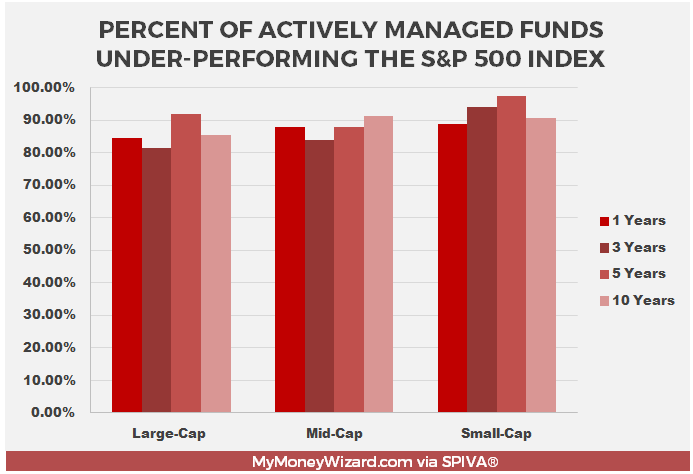
Unfortunately for our intro’s hypothetical prison friends who thought they finally agreed on something, when it comes to investing, hard work doesn’t actually pay off.
“But wait, that three fund portfolio vs. endowment comparison only covered the last 10 years. What about the rest of history?”
Great point. What sort of 3 Fund Portfolio performance can we expect if we go back further? As it turns out, that 6% performance of a Three Fund Portfolio is pretty typical.
- The Wall Street Journal also measured the Three Fund Portfolio’s performance over a decade, and arrived at 7%.
- PortfolioCharts.com went all the way back the 1970 and found the average return for a Three Fund Portfolio right around 6%, after accounting for inflation. (Going further back than 1970 presents some trouble, due to a slight roadblock about index funds not existing before 1970…)
If 6% doesn’t sound all too exciting, might I remind you of the rule of 72? If we earn 6% per year, we’re doubling our money every twelve years.
In other words, earning “just” 6% allows a lump sum of $100,000 to compound to $800,000 over a typical ~35 year investing career. Even with zero additional contributions!
To reach that 6% number, PortfolioChart’s analysis relied on a fairly standard 3 Fund Portfolio allocation… Hey, that brings me to my next point!
How to Choose a 3 Fund Portfolio Allocation
Okay, so we know the simple premise behind a Three Fund Portfolio. We want to choose three index funds, with each one representing the three main asset classes. (US Stocks, US Bonds, and International Stocks)
But how much of each of those three funds should we hold?
Well, that depends on you, more than anything.
- How old are you?
- Do you plan on withdrawing the money at any time in the near future, or are you just hoping to build an epic portfolio where you can live off the 4% rule once you reach financial freedom?
- And maybe most importantly, does the thought of your portfolio declining 40% in one year make you want to S#!T your pants??
These are important questions that no blog post can answer. But that’s not gonna stop me from trying!
Consider the following commonly used three fund portfolios:
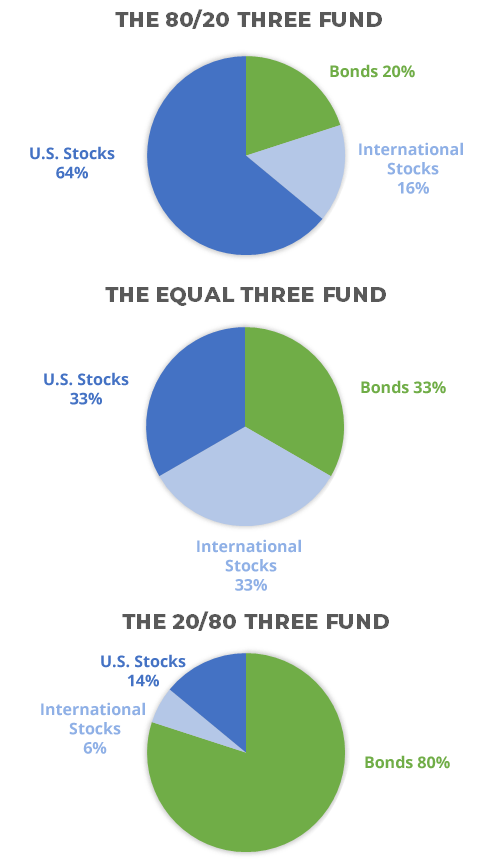
Each one of those different 3 Fund Portfolios could be perfectly reasonable for three different investors.
So, let’s find your ideal 3 Fund Portfolio!
Step 1) Decide on a Stock vs. Bond Allocation
This is probably the most important decision in designing your Three Fund Portfolio.
Because bonds are more stable and tend to move in opposite direction than stocks, the higher percentage of bonds in your portfolio, the more protected you will be from that potentially pants s#!tting event. BUT, that safety comes with a trade off… bonds have historically averaged just a 3% return, versus the 7% historical return of stocks.
To make this decision simpler, we can rely on a few different rules of thumb:
The 100 Minus Your Age Rule:
With this approach, you hold a percentage of bonds equal to your current age, and then allow stocks to make up the rest of your portfolio.
For example, a 20 year-old following this rule of thumb would hold 80% stocks and 20% bonds. By age 50, they’d adjust their portfolio’s allocation to 50% stocks and 50% bonds.
This certainly works for more cautious investors, but overall is a pretty conservative approach. With today’s low yields on bonds, plus humans living longer and longer, some notable investors have advised a slightly more aggressive modification…
The 110 (or even 120!) Minus Your Age Rule:
The same approach as before, but instead you’re holding a percentage of stocks equal to 110 (or 120) minus your age. Basic math hints at the effect here; we’ll hold a lower percentage of bonds throughout our entire lives, which means more emphasis on stocks.
Higher percentage of stocks = higher volatility, but also the potential for higher long term returns.
The 90/10 Rule:
Warren Buffett shocked a lot of retirement planners in a 2013 letter, when he casually mentioned that when he dies, he wants his wife to hold 90% of his money in stocks and only 10% in bonds, no matter the age.
Step 2) Decide on a US Stock vs. International Stock Allocation
Your choice between US Stocks and International Stocks might not have as big of an impact on your long term performance, simply because:
- Both are still under the “stocks” umbrella of asset types, so they’ll behave much more similarly than the naturally opposing nature of say, stocks vs. bonds.
- As the world grows more and more interrelated, US Stocks find themselves more and more correlated to international stocks. If you need proof of this, just check out the worldwide impact the United States’ 2008 financial crisis had on international stock prices.
In any case, there’s certainly still a diversification benefit to building out that third piece of the 3 Fund Pyramid. And just like our last step, we can use a few long standing rules of thumb as our guiding light down this confusing road:
The World Economy Approach:
Several famous investors suggest breaking down your stock holdings in the same proportions that they represent in the world economy.
If you have no idea what percentage of stocks make up the world economy, fear not! It’s actually pretty simple.
US Stocks represent roughly half of the world economy, while international stocks make up the rest. In this case, an investor would split the stock portion of their Three Fund Portfolio 50/50 between their chosen US Stock Market Index Fund and their chosen International Stock Market Index Fund.
(If you want to get extra-precise in this approach, Vanguard’s Total World Stock Index Fund (VTWSX) intentionally holds both domestic and international stocks in the exact proportion that they make up the world economy. Bonus! Your three fund portfolio just simplified down to just two!)
Vanguard’s 20-40% Suggestion:
Vanguard’s published research says 20% of your stock holdings is a good starting point for international exposure, and recommends going up to 40% for investors wanting more international exposure. Their own target retirement funds split 40% of their stock exposure in international funds.
Step 3) Tying it all together
Ultimately, the most common three fund portfolio split usually ends up around 60% stocks and 40% bonds, with a final breakdown as follows:
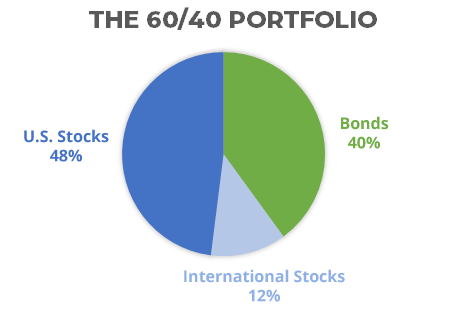
Of course, that’s not perfect for everyone. As always, it will depend on your outlook and goals.
On the more aggressive end of the spectrum, a 25 year old US Patriot using the 120-minus-age rule would be looking at a 3 fund portfolio like so:
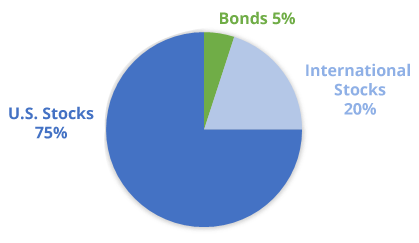
And on the far more conservative side, a 50 year old using the 100 minus your age rule and diversifying heavily into international markets might consider a portfolio like so:
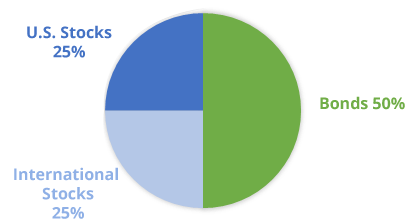
Chances are, you fit somewhere in between. The important part is choosing an allocation and sticking with it!
How to Actually Build a 3 Fund Portfolio (in less than 10 minutes!)
I realize that headline sounds like some kind of infomercial, but remember what we said about working hard not producing any better investing results?
That’s the whole point of this whole three fund portfolio thing. It really can be that simple!
Your toughest decision in building a three fund portfolio is simply which brokerage to use. I’m a huge fan of Vanguard, but any of the big guys have options that will work. And no matter who you choose, you can create an online account in about the same amount of time as signing up for Facebook.
Now what to do with your remaining five minutes?
Well, you just need to choose your allocation (we just figured that out above, remember?) and the specific funds to carry out that allocation. Here are my humble (and not-professional… don’t sue me!) opinions for your three funds.
How to build a three fund portfolio with Vanguard
- US Stocks: Vanguard Total Stock Market Index Fund (VTSAX)
- International Stocks: Vanguard Total International Index Fund (VTIAX)
- Bonds: Vanguard Total Bond Market Index Fund (VBTLX)
How to build a three fund portfolio with Fidelity
- US Stocks: Fidelity ZERO Total Market Index Fund (FZROX)
- International Stocks: Fidelity ZERO International Index Fund (FZILX)
- Bonds: Fidelity US Bonds Index Fund (FSITX)
How to build a three fund portfolio with Charles Schwab
- US Stocks: Schwab Total Stock Market Index (SWTSX)
- International Stocks: Schwab International Index (SWISX)
- Bonds: Schwab US Aggregate Bond Index Fund (SWAGX)
Building a three fund portfolio across multiple companies
What if you’re like me (and most other Americans) and your total portfolio is spread out across your work’s 401k, an IRA, and some after tax holdings?
Well, one of the beauties of the Three Fund Portfolio is it’s simplicity. With just three funds to manage, you can easily adjust and rebalance your three allocations across your different holding vehicles.
In other words, imagine your work’s 401k has access to a great, low cost index fund representing the US Stock market. But all your other 401k choices are overpriced, actively traded nonsense. In this case, there’s no shame in holding your US Stock fund entirely in your 401k, and then spreading out your International and Bond exposure across your IRA and after tax options.
On the other hand, if you’re one of the lucky few granted access to awesome index funds everywhere you look, then I suggesting shooting for tax efficient fund placement.
Final Thoughts on the 3 Fund Portfolio
If I were starting over from scratch today, there’s something about the beauty, simplicity, and performance of the Three Fund Portfolio that’s hard to resist. It’s approachable, understandable, and overall, really freakin’ effective.
With just three funds, you gain broad diversification, cut down on fees, and most likely, continue outperforming even the most professional money managers. All with a strategy that takes no more than 10 minutes to set up, and roughly the same amount of time to review once-a-year-or-so.
Speaking of which, Personal Capital’s free portfolio tracker is still the coolest tool I’ve ever found to track your allocation and make sure your portfolio stays on track. That way, you’ll keep rocking the 3 Fund Portfolio, and all its simplistic benefits, for decades to come.
My Money Wizard is an opinion based website. I am not a financial advisor, and the opinions in this article should not be considered financial advice.


This is how I got started investing. It’s great! I’ve actually supplied even further, to 100% equities, 100% total US stock market fund. I’ll add bonds when I get closer to FI, but I’m very comfortable with my 1 Fund Portfolio right now!
haha, can’t beat the simplicity of a 1 fund portfolio! It’s slightly riskier, but I did do something similar for a while.
Where do I go to purchase index funds? Hope to hear from u soon.
Cory,
You need an account with a broker. Vanguard, Fidelity, and Schwab are the most popular for the index fund investors. If you go with one of these, then you can follow the advice in the article.
What would be equivalents if using ETFs?
VTI: US stocks
VXUS: International stocks including emerging markets
BND: Bonds or BSV: Short term bonds
Thanks Simon.
Good stuff Money Wizard. I’m glad you mentioned that an international allocation may not be necessary. I’ve done some research for my blog, and the vast majority of companies you find in U.S. stock index funds have a huge percentage of their sales overseas. Usually in the 30-50% range, and some even higher than that.
For me, that’s plenty of international allocation. The world is very much and interconnected place now!
Great point!
Super thorough! I’ve set up a similar portfolio, but slightly altered including two additional funds. I guess we could always argue about slight variations.
P.S. I’m surprised Warren didn’t just tell his wife to put it 100% in stocks!
Thanks Steve!
Money Wizard if you hypothetically had all your assets in cash right now and we’re going to put everything into those three funds what % would you break them down into at your current age? I personally at age 31 like the 75% US stocks, 20% International, and 5% Bonds.
I’d probably do something similar as my current account balance, which looks similar to the 25 year old patriot example. I’m comfortable with that because I’ve already proven to myself that I can sit through an economic downturn without panicking.
Money Wizard
I am almost 61 probably working to almost 67. I just sold a rental property so besides my 80
0,000 my wife and I have in various funds 401 K’s, Roths and IRA i now have 275,000 in non qualified sitting in a savings account. I am thinking of the 2 or 3 fund approch with 2 Vanguard
Funds probably 65 / 35 stks to bonds
Your thoughts?
Just curious. What are your thoughts are REITs and in fitment (if any) to retirement portfolio?
I’m personally very risk averse at 28 so my portfolio asset allocation is as follows:
40% Mid Cap Index
35% Small Cap Index
15% S&P 500 Index
5% International Index
2.5% Aggregate Bond Index
2.5 REITs Index
I like REITs and own some myself. A lot of people add a little bit of REITs to make a 4 fund portfolio.
Are you sure you meant risk averse (aka risk avoiding)? At 80% mid-cap, small-cap, and international your portfolio is much more risky than a typical breakdown. Risk neutral/risk taking/risk tolerant would describe someone who’s happy with a riskier portfolio.
Gotcha, cool.
Yes, sorry I was saying tolerant but for some reason I typed averse.
Love your blog!
Thank you so much for this article. Quick and simple, I’m starting from scratch. I’m 40, lost everything a couple of years ago in what amounted to a divorce (though we weren’t married over the past two years I’ve had to cash out what little I had built and have shelled out over $112k). I have a pension and retirement HSA but need to start back over again in investing as I don’t want to just rely on my pension to be there…no thank you. I have an option for deferred compensation through work, but I don’t like that option and also feel I can do better with after-tax dollars.
So, with that knowledge, where would you start if you were me? Also, I may want options where I can start pulling some money out; between 2%-4% before age 59 1/2 so I want to avoid anything where I would be hit with penalties for pulling out money ahead of retirement.
Great read Money Wizard – should be compulsory for high school and college students!
Too many people (myself included) want to trade actively and chase the rush but the figures don’t lie. Think it was Jesse Livermore who said ‘the most money I ever made was by sitting on my hands”.
Looking forward to your next post!
Great article and very informative! I still think it’s worth buying individual stocks for the common investor if you do the proper research and stay informed on the companies you’re buying. One should definitely hold a majority of their investments in index funds, but serious gains can be made from investing into actual companies.
Great read Money Wizard!
I just got started in building my portfolio. Because I’m not a US citizen, most of the holdings will be on ETFs. And instead of funding my portfolio every month, I can only fund my portfolio every 3 to 6 months in order to reduce the total % of fees.
The 3 funds portfolio is GREAT for me because it means I can invest in one fund with a bigger amount once at a time, rather than to break my investment down into smaller pockets = higher fees!
Love this article! I just read The Bogleheads new book on this topic and I’m a huge fan. One typo… under 110 minus your age, I believe you mean stocks not bonds.
Fixed! Thanks!
Would this work in retirement as well, or go to an all value fund for a dividend play? Guess can always just sell capital – any thoughts? Know the value would be a bit less risky in a downturn, but not reflect growth in upturn.
Yeah it would, and lots of retirees do it.
The only thing that might change is a retiree is probably more worried about keeping what they already have vs. future growth. So you’d just switch to a more conservative position, aka a higher percentage of bonds.
I’m a grandpa to most of you guys, I’m sure, but I was able to go from a net asset value of $Broke to over a million in the past 17 years. I did it through hard work, a little luck and diligent investing in less diversified aggressive growth funds.
Now as I approach retirement, regarding the article, I’d like to suggest replacing the international fund with small cap value, but in a 5:1 ratio with Total US Stock Market (Vanguard VTI etf) and Small Cap Value (VIOV). Using PortfolioVisualizer.com you can clearly see that small cap value, even in small quantities (I prefer about 10-20% of core stock fund in SCV), does better than including an international fund with less drawdown and a smaller “worst year,” resulting in higher returns.
This is my portfolio at vanguard.
Vti 75% and viov 25%.
This is my second portfolio at M1finance.
Vti 50%
VIOV 20%
Vxus 20%
VTEB 10%
Both Taxable accounts. I’m 38 years old who wants to invest for a long term. What do you think?
For a non US resident how can one invest and create a portfolio similar to this?
Money Wiz,
If you are adding funds to your investment account monthly, like for a Roth, how do you suggest repurchasing funds without making it something you have to maintain monthly and constantly rebalance? Even though that seems low maintenance I’m sure I will break the habit of repurchasing monthly…
Vanguard lets you automatically contribute a predefined amount on a preset schedule, so you’ll never miss a month if that’s what you’re concerned amount. Outside of that just set a reminder in your phone to check the allocation every quarter, half-year, or year to re-balance if you’d like.
Hi…
just saw this article. Thanks for the info.
What would be the equivalent for Fidelity ETF’s for the 3 fund strategy?
Thank you.
Do you recommend using all of your cash in your Roth IRA for investing (using this strategy) or do you keep some cash in it?
best 3 fund portfolio using Ishares for investors in their early 70’s??? thanks
Great writing. And dead on accurate. The only thing you missed was account placement and tax loss harvesting.
I’m a brand new investor, age 39 with an old 401k (Target Date 2050 Fund), a new Roth IRA (85% FXAIX/15% FXNAX), and contributing toward a pension (can collect at age 53). I’d like to maximize my growth, but I’m only comfortable managing Index Funds right now. Is my approach any good, or do I need to consolidate my accounts & rethink my strategy? Thanks!
Really appreciate the article above. I bought the Fidelity US Stocks and International Index Fund as suggested, but the Fidelity FSITX, Bond Index, said no longer open to new investments. Can you recommend another Fidelity Bond Index?
Thank you
I agree that diversification is key. Also, most people are not good stock pickers so the mutual fund approach makes most sense. With the US stock market doing so great this year, taking a foreign approach to stock and bond mutual funds is always a great idea. The key is to have a plan and stick with it.
Great articles, and timely- I want to simplify my investments! A financial advisor has me in 12 mutual funds.. liking the 3 Fund Portfolio idea-
Closing in on 60 yrs old, its’ 2020 now— Would your advise change now with the new year and events? Thanks
Two main problems with the Bogleheads 3 fund portfolio concept:
First, the two stock funds (VTSMX and VGTSX) are extremely top heavy due to cap weighting. They have only about ~5% in small cap companies, but small cap tends to outperform large cap over time. Even among low-cost index funds it’s not hard to find small cap examples that have outperformed the total market indexes over time. In the US look at FSSNX, VIEIX, VSMAX and for international look at NAESX.
Second, bond yields are so low that they barely keep up with inflation. Recent research shows that 100% stocks is safer than 50/50 bonds/stocks. See “Why Stocks, Not Bonds, Assure Less Risk in Retirement” by Dave S. Gilreath, ABC News dot com, May 20, 2014,
May of 2014 is not recent research. Do you have a more recent article or info you could share?
Good article, any comparison’s for your European cousins?
3 years late here haha but would you still stand by this article? Any other advice? I have 5k in my IRA that I’m about to invest. I came to this article from Stephan Graham’s video.
Thanks
I have the 3 fund portfolio. in my M1 finance account. Its done quite well. Quick and easy set up. I think its a genius idea of investing.
It concerns me that the Bogleheads, or anyone experienced at successful investing would consider an average return of 6% good or acceptable. Assuming one lives off of 4% of their portfolio, you are annually LOSING money (the real value of your portfolio) considering the average rate of inflation is between 2.5-3%! Lately it is between 6-7%! One must achieve at least 7% average yearly returns to barely break even!
There are far better ways to safely achieve a higher rate of return, but many people are just not interested or too lazy to self-educate on investing.
https://mymoneywizard.com/average-stock-market-return/
Helpful